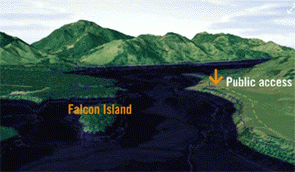
By Geoff Simmons
There has been a lot of noise about the Ruataniwha dam, which was proposed for the Tukituki catchment in the Hawkes Bay.
And rightly so, because the decision is a big deal for the way we manage our fresh water.
Have you ever wondered what it all means?
All dams aren’t evil – in fact given everything else we have done to our water, dams can actually help the environment.
The issue with Ruataniwha is what will be done with the water – in this case intensifying dairy farming and smoothing out the floods and dry periods of the Tukituki River.
More certainty about the volume of water flowing in the river is good, but the limits set by the Board of Inquiry imply that more dairy cows would be too damaging for the river – and in the process the Board has cast doubt on the science that has gone into the Government’s draft proposal for managing fresh water.
The way this issue is resolved could have big impacts for our environment and the economy.
Of course, the ideal is to have any waterway in a natural state and to leave it as it is. However, there aren’t many parts of New Zealand where this is still the case – pristine mountain rivers gradually deteriorate as they flow through our towns and farmland. There are many reasons for this.
Firstly we have cut down the forests that shaded the river and acted as a sponge to smooth out peaks and troughs in the water flow. The bare slopes left behind surrender loose soil and nutrients into the water.
Factories, farms and towns also all leach nutrients, sewage and chemicals into the water passing by.
Given this context, dams can actually help water quality. That’s right, help.
They do this by storing the water from a downpour (reducing flood damage) and then during dry periods releasing sufficient of that storage to keep the flow steady.
With any surplus water accumulated over and above that needed to keep the flow steady, we can irrigate the land, and pay for the dam.
This is where the problems with Ruataniwha really begin.
Dairy is the flavour of the month when it comes to land use, thanks to the high price for milk. However, despite dairy farmers now having to fence and plant their waterways, growth in the sheer number of cows on a dairy farm means more nutrients (especially nitrogen) now end up in the water.
The Board of Inquiry ruled that the Tukituki River, which runs from the Ruahine Ranges to the Hawkes Bay coast, can’t take any more nitrogen.
At the same time this case was heard, the Government released a draft proposal for managing fresh water. This included some indicators of water quality, such as nutrient levels, related to what the river is used for. As part of that, the water quality indicators included upper limits for nutrient levels that can’t be exceeded.
The idea of the upper limits is that this will stop us stuffing up any more of our fresh water, protecting the heritage of future generations.
The limit for nitrogen in the Government’s draft proposal was 6.9mg/L. Meanwhile the Board of Inquiry ruled that nitrogen in the Tukituki can’t rise above the current average level – which is about 0.8mg/L. That is just 12% of the Government’s draft upper limit.
If both of these numbers are based on science, how can they be so different?
The difference comes about because the ‘right’ upper limit depends on whether one is looking at the impacts on rivers of all factors working together or each factor individually.
The science on individual impacts is very clear, but when several things are impacting a river at the same time the results can be unpredictable. Nitrogen is a good example of this.
On its own, nitrogen in high quantities causes problems. This problem is known as nitrogen toxicity – when the nitrogen levels in water start to affect the animals living in it. At high levels, nitrogen starts bonding with blood cells in place of oxygen, eventually leading to death.
The government’s proposed upper limit (the environmental ‘bottom line’) of 6.9mg/L relates to the point where nitrogen toxicity stunts growth among the most sensitive 20% of species.
The WHO guideline for human drinking water is 11.4mg/L.
However, well before it reaches toxic levels nitrogen can promote the growth of weed or algae in a river. In certain conditions (if phosphorus and light/warmth are present) nitrogen at levels as low as 0.44mg/L can cause blooms of algae.
Some scientists also argue the “toxicity” limit for nitrogen should be lower anyway, because nitrogen starts having an impact on animals at 0.8mg/L. The analogy they use is that an alcoholic is sick long before their liver actually fails.
In the Ruataniwha case the regional council argued that because the Tukituki River had low levels of phosphorus adding more nitrogen wouldn’t cause algal blooms. We’ve seen this in some Canterbury rivers, where phosphorus is so low that nitrogen can rise close to that toxic level without algal blooms. But would this happen in the Tukituki?
The simple answer is that nobody knows.
The trouble is that phosphorus can be difficult to detect – it can hide out in soil, which might be stuck at the bottom of the river. Given that it can take decades for nitrogen to leach from a dairy farm into the river, by the time we know whether converting more farms was a bad idea it would be too late to stop the effects from earlier conversions.
In other words, it can be very difficult to know in advance whether adding nitrogen to a waterway will result in algal blooms or not. The only way we know for sure is by trying it, as we have in parts of Canterbury.
So the Board of Inquiry ruled that given these uncertainties, we can’t risk putting more nitrogen into the river than is present there now.
Just because we can’t detect phosphorus doesn’t mean it isn’t there, or can’t be there in the future. So under the precautionary principle, we need to manage both nutrients – nitrogen and phosphorus. That means no more dairy cows in the catchment – unless existing farms can reduce the amount of nutrients they are leaching.
The Government’s response to this will be interesting. Will it mean they take their draft plan for managing fresh water – which allows high nitrogen levels so long as no phosphorous is detected – back to the drawing board, or will they try to overturn the Board of Inquiry’s ruling that you can’t reliably predict phosphorous levels so therefore need to be far more conservative on how much nitrogen you permit to be leached? They have already given three clues that the latter might be the case.
The Prime Minister’s and Environment Minister’s response to the decision is that they expect an appeal – an unusual thing to do given the Board of Inquiry was Government appointed.
In apparently suppressing DOC’s original advice they have also shown that they are not interested in the public sector leading a transparent and open debate.
And finally their signaled changes to the Resource Management Act – ‘balancing the environment and the economic considerations’ shows a desire to head off these types of decisions in the future.
The environment is an unpredictable thing, and the science is rarely perfect. The internationally accepted way of dealing with this is the ‘precautionary principle’ – basically when in doubt, err on the side of the environment. The Government’s mooted Resource Management Act changes would be a step away from this principle.
These are big issues, which is why the Morgan Foundation has invested time and energy in understanding the science and policy on fresh water. We will be releasing the outcome of this work in the coming weeks.
Kiwis need to discuss the issues, because we are making decisions now that will have a huge impact on the legacy we leave for future generations.
-------------------------------------------------------
Geoff Simmons is an economist at the Morgan Foundation. This opinion piece was first published on the blog garethsworld.com and is reprinted here with permission.
4 Comments
Hi Geoff,
I have a couple of questions that relates to your statement,
'Given this context, dams can actually help water quality. That’s right, help.
They do this by storing the water from a downpour (reducing flood damage) and then during dry periods releasing sufficient of that storage to keep the flow steady.'
What is so beneficial about steady flow to water quality?
Is steady flow more beneficial to water quality in terms of sediment flushing that might occur from high rainfall = high water flow periods that would occur with normal seasonal rainfall patterns?
I'll limit the questions to water quality, rather than get into river 'ecosystems' that might rely on seasonal variations between high and low flow rates.
Creating this storage in an area of fairly low natural rainfall for dairying which needs huge amounts of water to turn out each litre of milk is extraordinarily daft. I also suggest to you that if this is the case, that land that is currently used for fruit and vegetable growing will be converte into black and whites and hello, we'll be having to buy our produce from overseas.
I am for it to provide more water for horticulture, I am utterly and completely opposed for dairying
So ANZ is pointing to a $6.25 milk price this season. I can see a few of those who had their hands up for this water pulling them down real quick.
As to a bloody great plug being placed in a river and giving a consistent river flow will improve water quality long term. Yea Rite.
With any surplus water accumulated over and above that needed to keep the flow steady, we can irrigate the land, and pay for the dam.
That sounds fine - store winter flows for release in summer - and is how the original Dutch Creek dam was supposed to operate (30 million m3 of water stored of which 10 million were for environmental benefits).
Ruataniwha's Makaroro dam includes flooding Dutch Creek but will operate on a quite different basis. HBRIC's business plan requires contracting sales of 104 million m3 with spot sales on top but from a dam with live storage of only 83.5 million m3. Sure, a minimum residual flow has been set so the Makaroro River's contribution to summer flows further downstream will be slightly higher for on average 10-12 days a year. The rest of the summer Makaroro flows will contribute less to downstream flows than previously as inflows are needed for irrigation due to the shortfall in storage volume.


We welcome your comments below. If you are not already registered, please register to comment.
Remember we welcome robust, respectful and insightful debate. We don't welcome abusive or defamatory comments and will de-register those repeatedly making such comments. Our current comment policy is here.